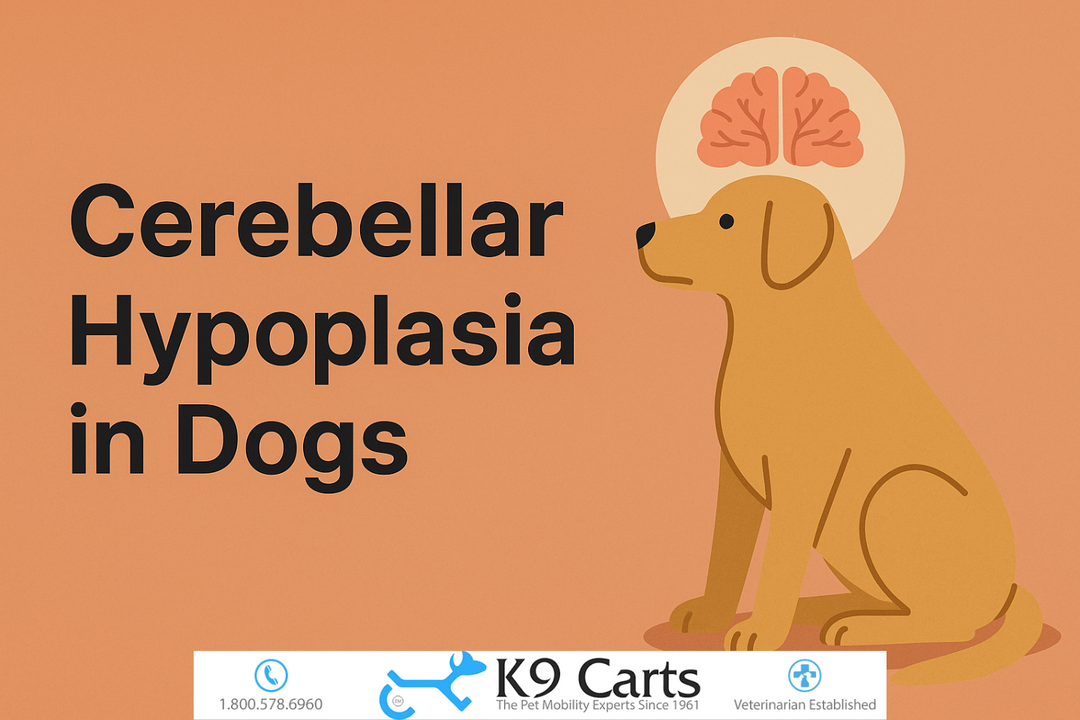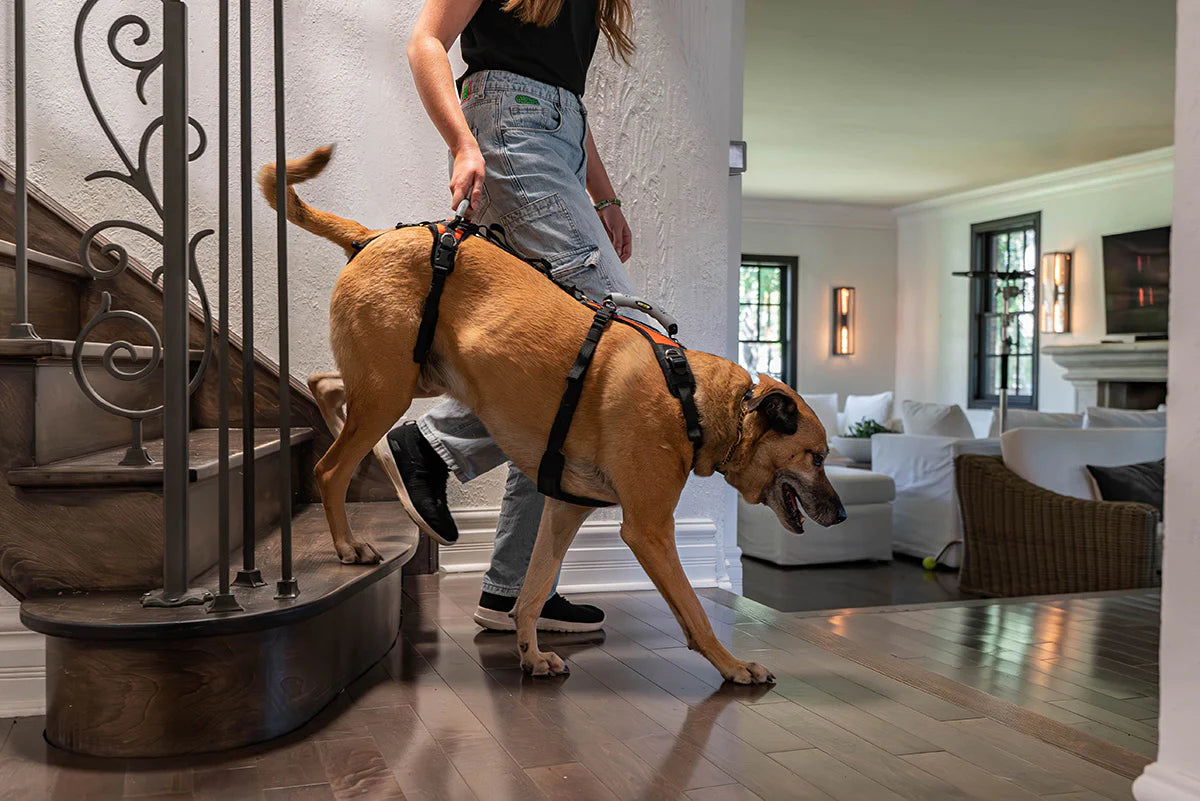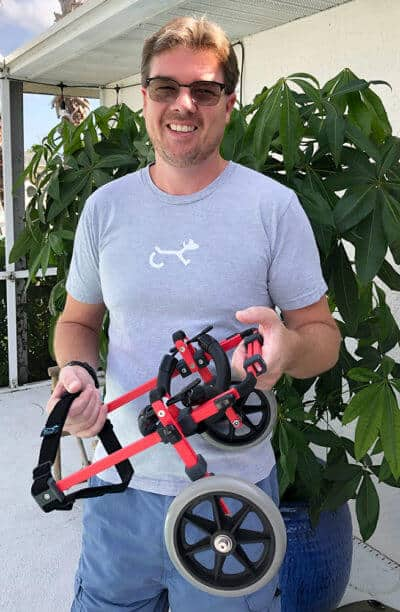Cerebellar Hypoplasia in Dogs: Causes, Symptoms, Treatment, and Management

Cerebellar hypoplasia is a brain condition that affects how dogs move. It’s usually present at birth and causes balance and coordination problems. Some dogs are only mildly affected and get around without much trouble, while others need more help. The good news is that dogs with cerebellar hypoplasia can still live long, happy lives when their needs are understood and supported.
This guide covers everything you need to know, from causes and symptoms to long-term care and mobility support.
What causes cerebellar hypoplasia in dogs?
Cerebellar hypoplasia happens when the cerebellum, the part of the brain that controls movement, doesn’t fully develop. This happens before birth. The condition is not contagious and doesn’t usually get worse over time.
There are a few main reasons this can happen:
1. Genetics
Some dog breeds are more likely to be born with cerebellar hypoplasia because of inherited traits. This is more common in purebred dogs, especially when both parents carry the same gene. If a dog is born with a genetic form of the condition, all puppies in the litter may be at risk.
2. Infections during pregnancy
If a mother dog gets sick during pregnancy, especially with certain viruses, it can affect how the puppies develop. Some infections can prevent the cerebellum from forming properly in the womb.
3. Toxins or poor nutrition
Exposure to toxins, chemicals, or poor-quality food during pregnancy can affect how the brain forms in unborn puppies. This is less common, but still possible.
Sometimes, the exact cause is never known. What matters most is learning how to care for a dog once the condition is diagnosed.
What are the signs of cerebellar hypoplasia in dogs?
The signs of cerebellar hypoplasia usually show up when puppies start walking, around 6 to 8 weeks old. These dogs often look unsteady or clumsy, but they’re not in pain.
Here are the most common signs to look for:
-
Wobbly walking or wide-legged stance
-
Head bobbing, especially when trying to focus
-
Trouble keeping balance when turning or standing still
-
Falling over more than usual
-
Jerky or exaggerated leg movements
-
Difficulty judging distances when jumping or reaching
Most dogs with cerebellar hypoplasia are alert, social, and playful. They eat normally, recognize people, and enjoy attention just like any other dog. Their brain is healthy in every other way except for coordination.
How is cerebellar hypoplasia diagnosed?
A veterinarian will start by looking at how your dog moves and ask when the symptoms started. Since cerebellar hypoplasia is usually present from birth, the signs won’t get worse over time.
To confirm the diagnosis, the vet may recommend imaging like an MRI. This lets them look closely at the brain and see if the cerebellum is underdeveloped. They might also run tests to rule out other possible problems like brain infections or injuries.
Is cerebellar hypoplasia treatable?
There’s no way to reverse or “fix” cerebellar hypoplasia. The brain doesn’t regrow or catch up after birth. But dogs with this condition can still have good lives. Most do not need medication.
Supportive care and a safe, stable environment are the most important parts of treatment. Dogs will usually adjust to their abilities over time, and with a few adjustments, many of them can enjoy normal daily life.
How can you help a dog with cerebellar hypoplasia at home?
Caring for a dog with cerebellar hypoplasia means making their environment safer and easier to move around in. It also means understanding their physical limits and helping them stay active without getting hurt.
Here are some of the most helpful changes you can make:
Make your home safer
-
Use rugs or non-slip mats on slippery floors to help with traction
-
Block off stairs or high furniture to prevent falls
-
Keep food and water bowls in sturdy, no-tip holders
-
Use soft bedding to protect joints and give a stable place to rest
Adjust daily routines
-
Keep food and water in the same place so your dog learns where everything is
-
Give extra time for potty breaks since it may take longer to get outside
-
Stick to a consistent schedule to reduce stress
Use gentle training and support
-
Reward calm behavior and focus with treats and praise
-
Avoid fast movements or loud sounds that may scare your dog
-
Be patient during play or walking time, especially if your dog falls or hesitates
Provide physical support when needed
Some dogs may benefit from extra support when walking, especially on long walks or uneven ground. In more severe cases, a mobility device such as a wheelchair can be very helpful.
At K9 Carts, we design lightweight, custom-fit dog wheelchairs that support balance and motion. For dogs with cerebellar hypoplasia, the goal isn’t just to move their legs forward, but to keep them steady while they walk. A well-fitted wheelchair can help reduce falls and make daily walks safer and more enjoyable.
Unlike some other devices, K9 Carts wheelchairs can be adjusted to fit dogs with partial mobility, not just full paralysis. This means dogs can still use their legs while getting the extra support they need.
What does long-term care look like for dogs with cerebellar hypoplasia?
Dogs with this condition don’t usually need special vet care after the diagnosis, unless they develop unrelated health issues as they age. The main focus is keeping them active, safe, and comfortable.
Over time, some dogs may experience muscle loss if they avoid movement due to fear of falling. That’s why it’s important to encourage activity in a controlled way. Short walks, physical therapy, or supervised play can help keep muscles strong and boost confidence.
Some families choose to use mobility aids later in life, even if their dog managed without one as a puppy. This often happens as the dog slows down with age or if daily movement becomes more difficult.
Can dogs with cerebellar hypoplasia live a full life?
Yes, absolutely. Many dogs with cerebellar hypoplasia live full, active lives with very few limitations. Their condition does not cause pain, does not affect intelligence, and does not usually lead to other diseases.
The most important thing is making sure your dog is safe from falls, supported during movement, and surrounded by people who understand their needs.
It may take some extra time and care, but these dogs are just as loving, playful, and capable of connection as any other dog.
Helping your dog thrive with the right support
When you live with a dog who has cerebellar hypoplasia, you quickly learn that a little extra effort goes a long way. With the right environment, gentle support, and safe ways to stay mobile, your dog can enjoy every part of life: from walks and playtime to cuddles and naps.
For families who want to give their dog more balance and freedom, a custom mobility aid can make a big difference. K9 Carts has been building supportive dog wheelchairs for over 60 years. Each one is handmade and tailored to your dog’s exact size, needs, and condition.
If you think your dog could benefit from added support, you can learn more about our custom dog wheelchairs at k9carts.com. Your dog deserves to move with confidence. And you deserve peace of mind knowing they’re safe every step of the way.








